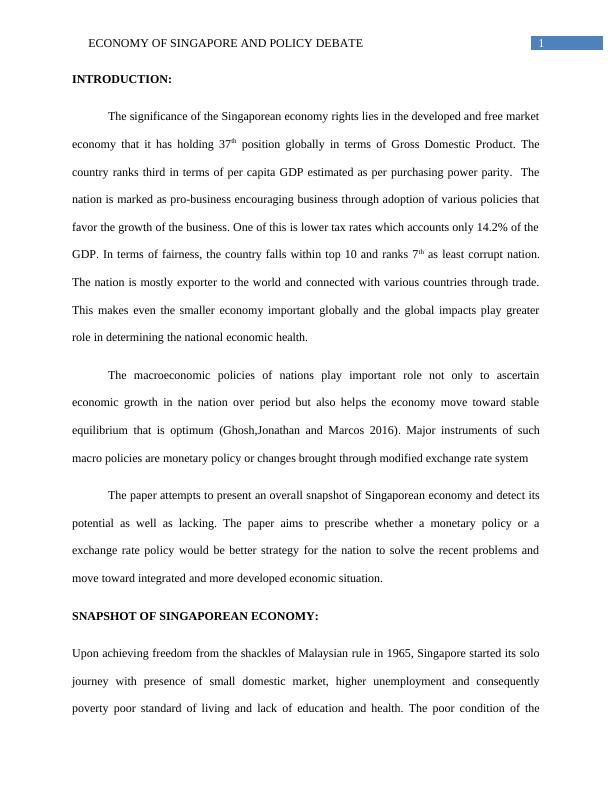Economy of Singapore and Policy Debate
12 Pages3025 Words37 Views
Added on 2020-03-16
Economy of Singapore and Policy Debate
Added on 2020-03-16
ShareRelated Documents
Running head: ECONOMY OF SINGAPORE AND POLICY DEBATEECONOMY OF SINGAPORE AND POLICY DEBATEName of Student:Name of University:Author Note:

1ECONOMY OF SINGAPORE AND POLICY DEBATEINTRODUCTION: The significance of the Singaporean economy rights lies in the developed and free marketeconomy that it has holding 37th position globally in terms of Gross Domestic Product. Thecountry ranks third in terms of per capita GDP estimated as per purchasing power parity. Thenation is marked as pro-business encouraging business through adoption of various policies thatfavor the growth of the business. One of this is lower tax rates which accounts only 14.2% of theGDP. In terms of fairness, the country falls within top 10 and ranks 7th as least corrupt nation.The nation is mostly exporter to the world and connected with various countries through trade.This makes even the smaller economy important globally and the global impacts play greaterrole in determining the national economic health.The macroeconomic policies of nations play important role not only to ascertaineconomic growth in the nation over period but also helps the economy move toward stableequilibrium that is optimum (Ghosh,Jonathan and Marcos 2016). Major instruments of suchmacro policies are monetary policy or changes brought through modified exchange rate systemThe paper attempts to present an overall snapshot of Singaporean economy and detect itspotential as well as lacking. The paper aims to prescribe whether a monetary policy or aexchange rate policy would be better strategy for the nation to solve the recent problems andmove toward integrated and more developed economic situation.SNAPSHOT OF SINGAPOREAN ECONOMY:Upon achieving freedom from the shackles of Malaysian rule in 1965, Singapore started its solojourney with presence of small domestic market, higher unemployment and consequentlypoverty poor standard of living and lack of education and health. The poor condition of the

2ECONOMY OF SINGAPORE AND POLICY DEBATEnation showed in the estimated unemployment figure, which reached as high as 14% (Tremewan2016). Since then the nation focused on making the country attractive destination for investmentand capital inflows. The imitative proves its success in the fact that by 2001 the nation has beenable to receive foreign investments in the manufacturing production by 75% and in themanufacturing export by 85% (Tremewan 2016). The investment boosted the production to meetincreased demand and this further led to capital accumulation. Overtime this led to increasedsavings and interest rates. This enhanced the capital stock of the nation by 33 times since it wasin 1992. The capital-labor ration increased 10 times. With rising wage shares of GDP andhousehold consumption backed by increased income the standard of living improved and thenation reached middle income level from low income nationTwo biggest strategies adopted by the nation was self-reliance and skill developmentwithin workforce that took care of the deficiencies the nation had in terms of income and basicamenities of life. Public companies driven by government comprise the major part of the nationaleconomy. These companies are held through sovereign wealth funds that buys majority shares inthose firms. The nation is biggest financier in terms of foreign direct investment outflow.Positive economic and political climate of the nation has also made it receive capital inflowsfrom global institutions. The policies and strategies brought 8% of GDP growth rate in the nationfrom 1960 to 1999. The rate fell to 5.4% following Asian Financial Crisis (Rodan 2016). Theeconomy picked up its growth reaching 9.9% in 2001 even though the slumps in the USA, Japan,European countries had negative impact on the growth condition of Singapore. Since 2004 thenation showed remarkable growth rateThe economy of the country lies mostly on three broadly visible sectors Banking,Biotechnology and Energy & Infrastructure. Apart from these, telecommunication and retail

3ECONOMY OF SINGAPORE AND POLICY DEBATEsector also plays significant role in determining the growth of GDP overtime. The manufacturingsector accounts highest almost 21% to GDP followed by retail and whole sale contributing 17%,business by 14, financial services and transportation by 12%, construction by 4% and others 20%(Rodan 2016). Though the nation is dominant in service production, it also pioneers inmanufacturing of chemicals and electronics.CURRENT ECONOMIC ISSUES:In the recent time period the nation records GDP at US$298.1 billion with currentgrowth rate of 1.7% in 2016 and 2.9%v in 2017 (Tremewan 2016). The increasing trend of thegrowth trend is due to increasing industrial production as well as export. The industrialproduction growth rate has been in 1% in 2016 estimation.The open market operation of the nation has allowed it to receive freedom in trade,business, investments and financial operations. The efficient regulation of the economy has ledto relaxation in the business operation as well as provided freedom to labor and money market.The country has managed to maintain good fiscal health with lower tax burden and higher levelof government spending.

End of preview
Want to access all the pages? Upload your documents or become a member.
Related Documents
Economic Performance of Singapore: GDP, Unemployment and Inflation Analysislg...
|10
|2444
|84
The Economy of Singaporelg...
|13
|2834
|82
Economic Performance Analysis Singaporelg...
|15
|2799
|75
Unemployment in Australia 2012-2017 - Assignmentlg...
|18
|3865
|41
Economy of Singaporelg...
|11
|3033
|220
Economics Assignment | Economy of Malaysialg...
|25
|4443
|58
